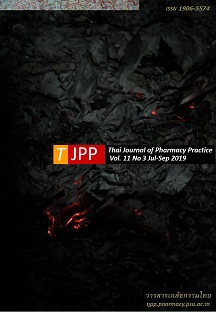สถานการณ์การนำผู้ป่วยโรคไม่ติดต่อเรื้อรังที่สูบบุหรี่เข้ารับการบำบัดเพื่อเลิกบุหรี่
Main Article Content
บทคัดย่อ
วัตถุประสงค์: เพื่อศึกษาสถานการณ์การนำผู้ป่วยโรคไม่ติดต่อเรื้อรัง (non-communicable diseases: NCD) ที่สูบบุหรี่เข้าสู่การบำบัดเพื่อเลิกบุหรี่ของโรงพยาบาลในพื้นที่จังหวัดพะเยาตามหลัก 5A (ask, advise, assess, assist, arrange follow-up) วิธีการ: การวิจัยนี้เป็นการศึกษาเชิงคุณภาพที่เก็บข้อมูลจากการสัมภาษณ์เชิงลึก ผู้ให้ข้อมูลประกอบด้วย 2 กลุ่ม ได้แก่ บุคลากรทางการแพทย์ที่ปฏิบัติงานเกี่ยวข้องกับคลินิกเลิกบุหรี่ และผู้ป่วย NCDs ที่มารับบริการในคลินิกของโรงพยาบาล 8 แห่ง ในสังกัดกระทรวงสาธารณสุขในจังหวัดพะเยา ประเด็นหลักของการสัมภาษณ์ คือ กระบวนการให้บริการเลิกบุหรี่สำหรับผู้ป่วย NCDs ของโรงพยาบาล ผลการวิจัย: โรงพยาบาลที่ศึกษาบำบัดผู้ป่วยเพื่อเลิกบุหรี่ในคลินิกจิตเวชซึ่งเป็นคลินิกฟ้าใสจำนวน 4 แห่งจากทั้งหมด 8 แห่ง ผู้ป่วย NCDs ในโรงพยาบาลที่ศึกษาทั้งหมดได้รับบริการเลิกบุหรี่เป็นมาตรฐานการปฏิบัติเดียวกับผู้ป่วยโรคอื่น ๆ ของโรงพยาบาล การเข้าสู่การบำบัดในคลินิกเลิกบุหรี่เกิดใน 3 ช่องทาง ได้แก่ การคัดกรองจากแผนกต่าง ๆ ในโรงพยาบาล การคัดกรองจากโรงพยาบาลส่งเสริมสุขภาพตำบล และการสมัครใจขอใช้บริการเอง บุคลากรจะให้คำแนะนำเพื่อโน้มน้าวให้ผู้ป่วยเลิกบุหรี่ และส่งตัวไปยังคลินิกเลิกบุหรี่ของโรงพยาบาล ผู้ป่วยที่เข้ารับการบำบัดจะได้รับคำปรึกษา ยา และการติดตามผลจนครบ 1 ปี ยาที่ผู้ป่วยได้รับมากที่สุดได้แก่ น้ำยาบ้วนปาก nortriptyline ชาชงหญ้าดอกขาว และ vitamin C ตามลำดับ กระบวนการแนะนำผู้ป่วยให้เลิกบุหรี่ที่ดำเนินการเหล่านี้เป็นไปตามหลักการเวชปฏิบัติที่ยอมรับทั่วไป และปรับเปลี่ยนตามบริบทของโรงพยาบาล อย่างไรก็ตาม ปัญหางบประมาณส่งผลต่อรายการยาที่มีในโรงพยาบาลและความต่อเนื่องในการบำบัดผู้ป่วย การกำหนดตัวชี้วัดบางตัวในกระบวนการประเมินผลลัพธ์การบำบัด และการติดตามผู้ป่วยด้วยการนัดมายังโรงพยาบาลไม่มีประสิทธิภาพเท่าที่ควร แม้ว่าจะมีอุปสรรคในการดำเนินการอยู่บ้าง ผู้ป่วย NCDs ที่เข้ารับบริการยังคงมีความพึงพอใจในการรับบริการเลิกบุหรี่จากโรงพยาบาลที่ตนรับบริการอยู่ สรุป: โรงพยาบาลที่ศึกษามีการดำเนินการตามหลัก 5A ครบทุกกระบวนการ แต่อาจมีบางแห่งที่ไม่มียาที่ใช้ในการเลิกบุหรี่ การวิจัยในอนาคตควรศึกษาถึงการพัฒนาระบบการติดตามผู้ป่วยหลังเข้ารับการบำบัด การเพิ่มช่องทางการประชาสัมพันธ์เพื่อการเข้าถึงบริการ และการปรับเปลี่ยนบริการเป็นคลินิก NCD แบบเบ็ดเสร็จเพื่อเพิ่มประสิทธิภาพในการเลิกบุหรี่
Article Details
ผลการวิจัยและความคิดเห็นที่ปรากฏในบทความถือเป็นความคิดเห็นและอยู่ในความรับผิดชอบของผู้นิพนธ์ มิใช่ความเห็นหรือความรับผิดชอบของกองบรรณาธิการ หรือคณะเภสัชศาสตร์ มหาวิทยาลัยสงขลานครินทร์ ทั้งนี้ไม่รวมความผิดพลาดอันเกิดจากการพิมพ์ บทความที่ได้รับการเผยแพร่โดยวารสารเภสัชกรรมไทยถือเป็นสิทธิ์ของวารสารฯ
เอกสารอ้างอิง
2. World Health Organization. WHO report on the global tobacco epidemic: enforcing bans on tobacco adver tising, promotion and sponsorship Geneva 2013 [on line]. 2013 [cited Jul 6, 2017]. Available form: apps. who.int/iris/bitstream/10665/85380/1/9789241505871_eng.pdf.
3. Thai Health Promotion Foundation. Situation of NCDs in 2016 [online]. 2016.[cited August 8, 2018]. Available from: www.thaihealth.or.th/microsite/cont ent/5/ncds/.html.
4. Thai Health Promotion Foundation. The advantages of smoking cessation [online]. [cited Aug 8, 2018]. Available from: www.thaihealth.or.th/Content.html
5. Manawatthanawong A, Chaiyasong S, Limwattana non S, Limwattananon C, Tisayaticom K, Patchara narumol W, Tangcharoensathien V. How many NCD patients have risky health behaviors?: Report from Health and Welfare Survey. Journal of Health Systems Research 2017; 11:345-54.
6. Pitayarangsarit S, Punkrajang P, Chotbenjamaporn P, editors. The situation of tobacco control in Thailand, 2016. Bangkok: Jaroendeemankongkarn pim; 2015.
7. Community Development Department, Phayao Pro vince. Phayao: Basic minimum needs information/ village basic information. Phayao: Community Deve lopment Department; 2014.
8. Karnjanapiboonwong A. NCDs “kick off to the goals”. Bangkok: Thai NCD network. 2016.
9. Bureau of Tobacco Consumption Control, Ministry of Public Health. Second nation strategic plan for tobacco control 2016-2019. Nonthaburi: Nice Earth Design; 2016.
10. Wongyai P. Development of smoking cessation services: NCD clinic [online]. 2011 [cited Jul 6, 2017 ]. Available from: www.med.cmu.ac.th/hospital/nis/ downloads/?p=461
11. National Alliance for tobacco free Thailand. Treatment guidelines for smoking cessation in Thailand for doctors and health professionals. Bangkok: Medical Association of Thailand; 2009.
12. Tipyawong T, Ratanasaeng P. Smoking cessation services system in Thailand. Department of Medical Services Journal. 2015; 40: 94-102.
13.Hathaichanok S, Pitayarangsarit S, Iamanan P, Tangcharoensathien V. Asessment of smoking ces sation services in Public Health Ministry-Affiliated hospitals. Journal of Health systems research. 2015; 9: 241- 52.
14. Wannasewok K. Preparing before going to meet a psychiatrist [online]. 2012 [cited Mar 4, 2017]. Available form: www.si.mahidol.ac.th/sidoctor/e-pl/ articledetail.asp?id=941.
15. Pimpak T, Chaikoolvatana A, Pheunpha P. Quit smoking behavior of current smokers: A case study at Pharsai Clinic, Ubon Ratchathani University. Srinagarind Medical Journal. 2015; 30: 282-91.
16. Ministry of Public Health. Drug use in smoking cessation [online].Bangkok: National Drug Policy Group; 2017 [cited Apr 2, 2018]. Available from: ndi.fda.moph.go.th/uploads/evidance_file/20170503183600.pdf.
17. U.S. Department of Health and Human Services. Treating Tobacco Use and Dependence: 2008 Update [online]. 2008 [cited Jun 18, 2018]. Available from: bphc.hrsa.gov/buckets/treatingtoba cco.pdf
18. National Health Security Office. Support for smoking cessation services for the year 2012 [online]. 2017 [cited Mar 22, 2017] Available from: www.nhso.go. th/eng/FrontEnd/page-contentdetail.aspx?Content ID =NTkwMDAwMTI5


